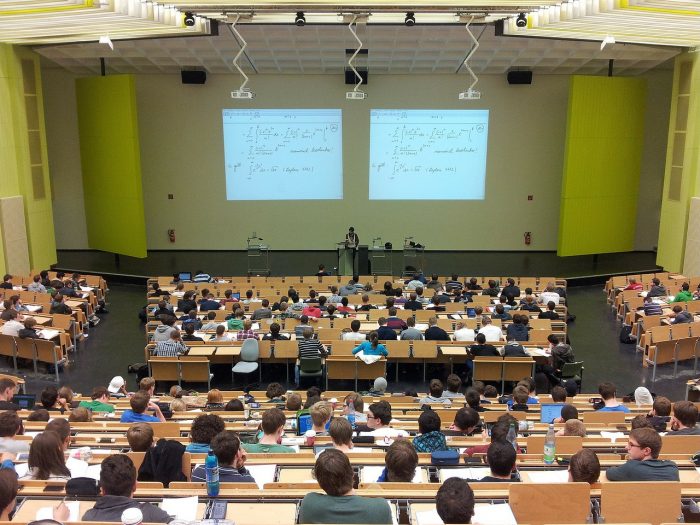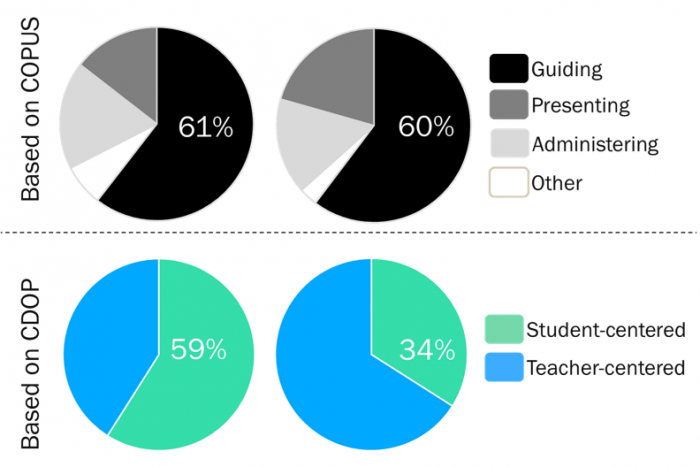
Understanding what instructors say and how they respond to students “in the moment” is as important as the activities and the learning environment they create to engage students. Time to listen in?

Image by nikolayhg via Pixabay is licensed under CC0
A decade or two ago, one would have been hard-pressed to find college lecture halls full of science students sitting at roundtables, alive and interacting.
In the science classes of yesteryear, traditional stand-and-deliver lectures held sway – especially in large enrollment courses. Rows and rows of students sat still in theater-like auditoriums, listening intently as their professors lectured behind a podium.
However, for some time now, universities have started investing vigorously in the so-called Active Learning Classrooms. A high percentage of science faculty are ditching the traditional lecture in favor of small group learning. Students are up and about, dialoguing and interacting. This transformation is attributed to the mounting evidence that active learning strategies improve student performance outcomes and lower course failure rates across STEM disciplines.
But what happens in engaged STEM classrooms?
To answer this question, various studies have used classroom observation tools to examine what STEM instructors and students are doing in their classrooms. A popular protocol, the Classroom Observation Protocol for Undergraduate STEM (COPUS), allows observers to document 12 instructor and 13 student behaviors during each 2-minute time interval of a class session. COPUS captures instructor behaviors ranging from lecturing to guiding small group activities and student behaviors ranging from listening to working in groups and answering questions.
A recent study using COPUS examined instructor and student behaviors in more than 2,000 classes taught by more than 500 STEM faculty across 25 institutions. It turns out that traditional lectures still dominate. Only 27 percent of the STEM classrooms featured interactive lectures that had the students engaged in some none-lecture activities. On the other hand, fifty-five percent of the observed classes used didactic lectures.
A Tool for Measuring Classroom Talk
COPUS and similar protocols provide useful information about classroom instructional behaviors – what the instructors and the students are doing, how instructors create the learning environment and activities, etc. But the increased emphasis on student-instructor interactions places a high premium on classroom talk and the performative aspects of teaching – how instructors actually put instructional activities into practice as well as respond to students “in the moment.”
In a new study published in PLOS ONE, we offer a novel classroom observation protocol, the Classroom Discourse Observation Protocol (CDOP), which focuses specifically on “classroom talk” as the unit of analysis. CDOP is unique from many other extant observation protocols in that it does not observe or measure the activities occurring in the classroom – what the instructor and students are doing – but instead solely considers what the instructor is saying as they interact with students. It is essentially a tool to eavesdrop on classroom talk.
Through an inductive–deductive coding process, we identified commonly occurring classroom talk moves among a group of biology instructors (n = 13, 37 class session) teaching in Active Learning Environments. Consequentially, the CDOP includes various categories of talk moves that can be described as either instructor-centered or student-centered depending on the instructional intent of the codes.
An example of a classroom talk move that we frequently saw during small-group activities was when an instructor mainly shares information about content with students and has a more authoritative voice in the dialogue. In the CDOP, this move is codified as sharing. In a constructing move, on the other hand, an instructor asks students to build knowledge by interpreting and/or making judgments based on evidence, data, and/or model. Both of these talk moves can be observed in the same classroom but are at the two ends of the classroom talk spectrum.
A Delicate Dance
Overall, the CDOP contains 15 talk moves in which the instructor either talks about the content (instructor-centered) or asks the students to talk about the content (student-centered). These can be subcategorized into smaller groupings that allow cross-comparison across classrooms. It is the delicate balance of using these different talk moves that can lead to a rich classroom discourse.

Figure courtesy Abdi Warfa
The CDOP coding scheme and its associated coding matrix allows observers to capture, on a 2-minute interval sampling basis, the frequency of instructor talk moves occurring over the course of a class period. We found high inter-rater reliability among multiple coders when using the CDOP (Cohen’s Kappa values of 0.75).
We also found that the CDOP is able to detect subtle differences among instructors who are otherwise using similar active learning strategies. For example, two instructors could be engaging students in the same active learning activities; yet, based on their CDOP profile, one could be using more instructor-centered moves, while the other enacts more student-centered moves. Thus, the development of CDOP profiles makes it possible to explore how different instructors orchestrate classroom talk.

Figure courtesy Abdi Warfa
The PLOS ONE article describes the development and validation of this tool and compares its results to the COPUS results of the same classrooms. Overall, CDOP offers instructors and researchers a unique perspective on how the learning environment is supported and managed by the instructor. We envision it used by instructors as a formative tool that informs their teaching strategies, as well as a professional development tool to explore instructional practices that are the most effective when teaching in undergraduate STEM learning environments.








